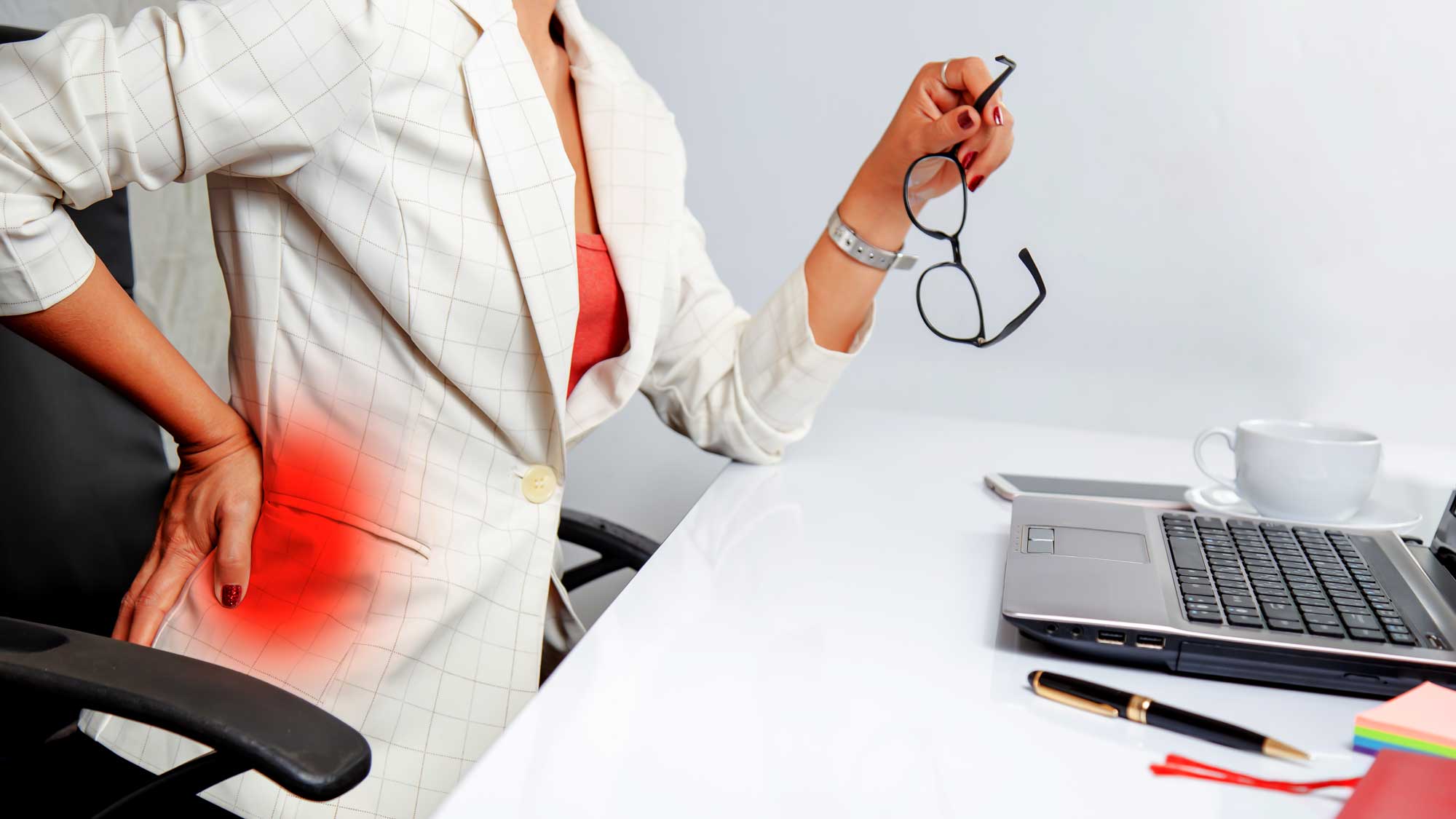[et_pb_section fb_built=”1″ _builder_version=”4.6.5″ _module_preset=”default” custom_padding=”0px||0px||true|false” hover_enabled=”0″ sticky_enabled=”0″][et_pb_row _builder_version=”4.6.5″ _module_preset=”default”][et_pb_column _builder_version=”4.6.5″ _module_preset=”default” type=”4_4″][et_pb_text _builder_version=”4.6.5″ _module_preset=”default” hover_enabled=”0″ sticky_enabled=”0″]
In the UK, arthritis and musculoskeletal (MSK) conditions impact more than 17 million people.
Musculoskeletal conditions like low back pain remain one of the biggest contributors to morbidity. In fact, somewhere between one-in-three and one-in-five people have a musculoskeletal pain condition.
A sedentary lifestyle is a leading cause of MSK conditions. If you find yourself working at a desk for hours at a time, it’s likely you’ve experienced body aches and pains.
But you don’t have to suffer in silence. If pain relievers aren’t cutting it, learn what you can do to relieve body pain at work.
1. Back Stretches for a Sore Back
If you’re feeling sore, desk stretches can alleviate some of the stiffness. For best results, stand up when you stretch. You can do these simple back exercises at work or at home.
Standing Trunk Extension
Stand with your feet about shoulders width apart and place your hands on your lower back. Lean back until you feel a slight pressure your lower back and can feel the stretch in your abdominal area.
Hold for a few seconds and then repeat for a set of ten.
Hip Flexor Stretch
Stand up and hold onto your desk for support. Place one foot on a chair behind you. Your foot on the ground should be pointing forward and the knee slightly bent.
Move your pelvis forward and contract your glutes at the same time. You’ll feel this stretch in your thigh and at the front of your hip.
Hold the position for about 15-20 seconds and repeat about 3-5 times. Make sure to do both sides.
2. Neck Stretches
Experiencing neck strain at work? If so, consider trying these workplace stretches meant to relieve stiffness.
To rotate your neck, sit or stand with your head facing forward. Turn your head to one side and try to stretch past your shoulder. Then repeat on the other side.
Lower your head forward and rest for about 15-30 seconds then lift your head again. Next, move your head back and tilt your chin towards the ceiling. Hold for ten seconds before lifting your head.
Repeat these moves a few times and do these stretches at least once a day.
3. Correct Your Posture
Experiencing back pain with a desk chair at work? Correcting your posture can help by reducing the strain put on your body and joints.
When you’re sitting at your desk, your monitor should be about an arm’s length away. Your wrists should be straight and level with your elbows or a bit below. Knees should be at or around the same level as your hips and feet flat on the floor.
Adjust your chair height if necessary and make sure that your chair also supports your spine. If you have armrests, adjust them so your elbows bend around 90 degrees.
4. Take Breaks
Sedentary lifestyles contribute to a higher risk of diseases like obesity and high blood pressure. But breaking up the workday with short periods of activity can make a big difference in your health.
Office employees should stand up for their health to make time at work less sedentary. The goal is to stand for at least two hours a day, which is often best accomplished by taking breaks. Every thirty minutes to an hour, stand up and stretch or move around for a bit.
You can take shorter breaks at your desk to roll your shoulders or relax your eyes. To reduce eye strain, focus on a spot away from your computer in the distance for about 20 seconds.
5. Adjust Your Monitor
Adjust your computer monitor to make sure it’s at the correct height for you. Your screen should be an arm’s length away and at or slightly below eye level.
You can adjust the angles of most monitors so find one that puts the least strain on your neck. Adjustable monitor stands allow you to add height to your monitor and work well with standing desks.
6. Buy a Fitness Tracker
Fitness trackers help office workers stay active and reduce sedentary habits.
Fitness trackers keep track of your step count and alert you when you’ve been inactive for a long period of time. You can set a fitness wearable to vibrate when you need to get up and move around.
And it’s easier to get those steps in than you might think. Take the stairs instead of the elevator, refill your water bottle, or take a short walk outside.
7. Avoid Looking at Your Phone
Sometimes, we spend more time on our phones at work than we should. But the motion of looking downward strains our spine and has even created a new ailment.
Text neck is the term for the pain we feel in our neck when we look at our phones, tablets, or other digital devices for too long.
For office workers, it’s best to limit the time you spend looking at your phone when possible. Instead of browsing the web or watching videos on break, consider reading a book or talking to co-workers.
8. Use a Portable Massager
Need on-the-go relief for your sore muscles? Give your body the relief you need by targeting specific sore areas. Invest in a portable massager designed to pamper your body no matter where you are.
Portable massagers are also great to take with you on business trips or when you travel.
9. See a Chiropractor
If your body pain doesn’t seem to go away, it may be time to schedule a visit with a medical professional. Seeing a chiropractor or physical therapist could be exactly what your body needs to feel limber and relaxed again.
If your pain persists for a long period of time, talk with your doctor. You may be suffering from chronic pain or another underlying condition.
Chronic pain affects between one-third and one-half of the population of the UK, according to data from published studies.
Overcoming Pain While Working at a Desk
Do you experience pain while working at a desk on a daily basis? If you do, you’re not alone. But you don’t have to quit your job if you experience body pain due to your workplace environment.
If you can, buy a standing desk. If that’s not possible, you can still do back or neck stretches while at work to provide relief for sore muscles. If your pain persists, consider speaking with your doctor or seeing a chiropractor.
Looking to pamper yourself even more? Check out our e-store to see our selection of massagers and other massage products in person.
[/et_pb_text][/et_pb_column][/et_pb_row][/et_pb_section]




